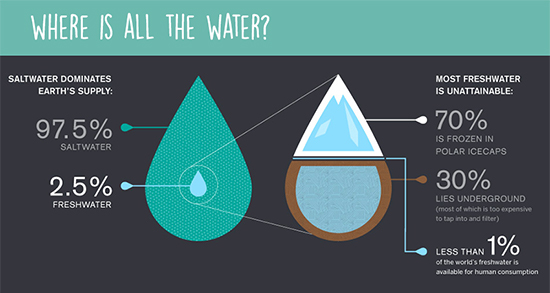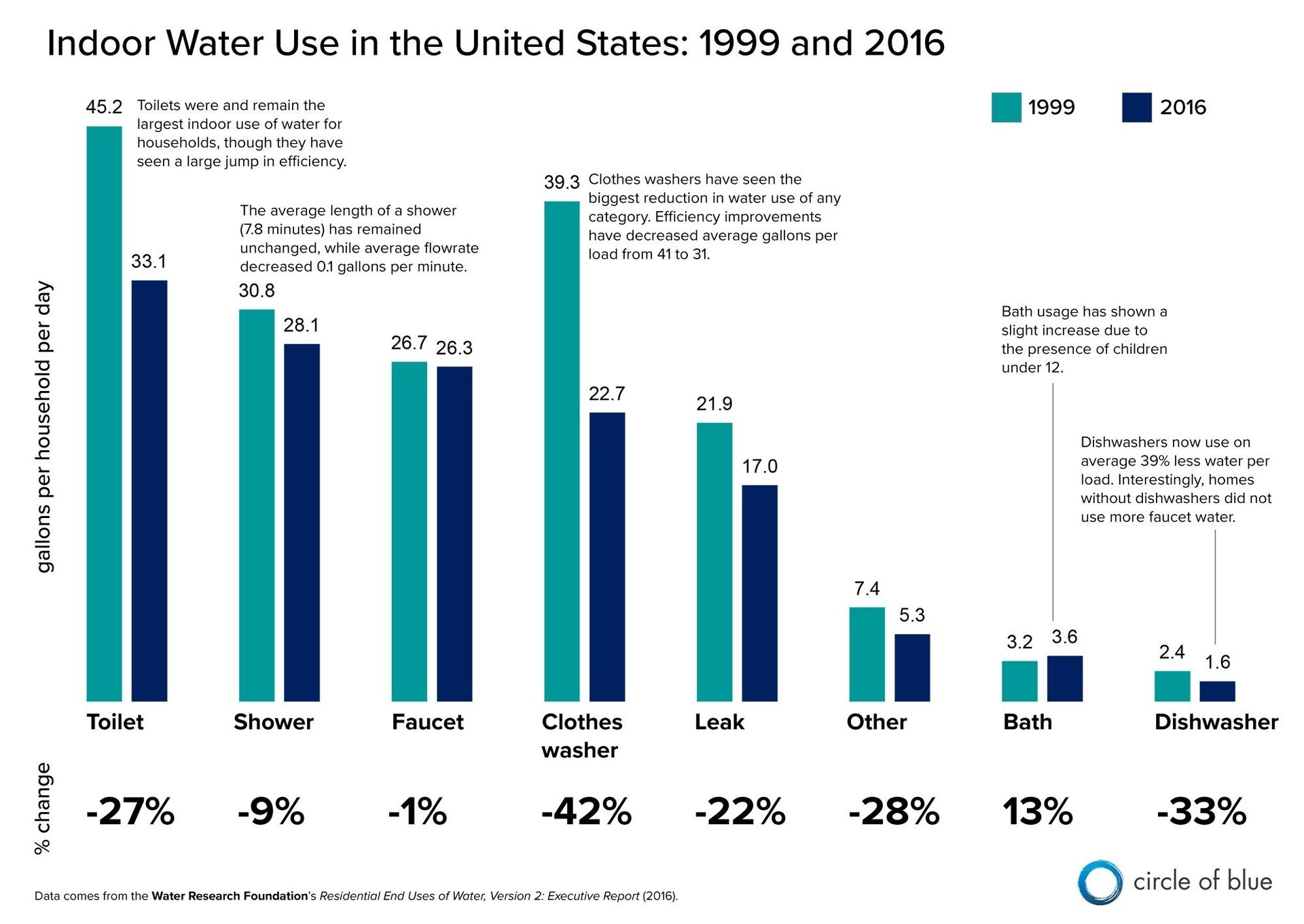El agua es un recurso finito.
El agua dulce es un recurso finito. Aunque el agua es la segunda sustancia más abundante del universo, aquí en la Tierra es un recurso limitado. La imagen siguiente explica que sólo el 2,5% de toda el agua de la Tierra es agua dulce y sólo alrededor del 1% de ella es actualmente accesible para el consumo humano.

On Earth, water occurs in a closed loop, so the amount of it is constant. In your daily life, there are two essential aspects of water use in the home that you need to be aware of 1) water use consumes a finite resource and 2) water use adds to your energy load (more info here). In the US and Puerto Rico, home water use breaks down roughly into 60% indoor, 30% outdoor and another 10% that is lost to leaks. The challenges that we face in Puerto Rico are similar to costs faced in many places around the world: increased power generation costs, increasing cost of utility water, public water supply shortages, and water quality issues.
La infraestructura de agua de su casa le permite bañarse, limpiar, beber y cocinar, y estas actividades implican diversos accesorios como lavavajillas, inodoros, lavadoras, grifos y duchas. Las instalaciones exteriores suelen incluir mangueras para regar jardines, lavar coches, llenar piscinas, etc. Pero resulta que hay otros factores, además de los accesorios, que los estudios han demostrado que pueden contribuir a un mayor consumo de agua. Estos factores son los inquilinos (frente a los propietarios de viviendas), las personas que viven en edificios más grandes o más antiguos, los que viven en una zona metropolitana y los que tienen un nivel educativo y unos ingresos más altos. Numerosos aspectos de la conservación del agua nos afectan en casa. Algunos son indirectos, como la distribución del agua por parte de los servicios públicos, la generación de energía para bombearla, la gestión de las aguas pluviales, etc. Otros son directos y son los que queremos analizar. Entre ellos están la recogida de aguas pluviales, los sistemas de aguas grises, el agua potable y el tipo de instalación. Cada uno de estos temas merece más tiempo, pero veamos cómo nos ayudan las instalaciones a abordar el problema de la conservación del agua.
The implementation of programs like Energy Star™ and the overall trend towards water-saving fixtures have led to a 22% decline between 1999 and 2016, with the majority of that decline coming from more efficient toilets and clothes washers. In fact, “nearly all the decline in residential indoor water use in the last two decades is due to more-efficient fixtures.”. Low-flow shower heads and faucets are now plentiful and easy to use. We have known for a while that dishwashers use less water than hand washing does, but washing machines have also reduced their water consumption by nearly 50%. It is a good time to upgrade old machines. But simply replacing water-wasting fixtures is not enough to correct and improve standard plumbing practices. Fixtures like low-flow toilets are a good idea, but have you ever asked yourself why I am using potable water to flush my toilet? Reuse makes a lot of sense for wastewater flows, and it requires minimal effort. A simple grey-water system allows homes to recycle the water from the shower, washing machine, and bathroom sink and plumb it back through to the toilets and hose bibs. Grey water systems don’t rely on expensive, toxic chemical treatments and are energy-efficient to run.
¿Qué puede hacer? Pues resulta que mucho. No a escala mundial, por supuesto, pero usted, su familia y sus vecinos pueden dar pasos positivos que crearán un impacto acumulativo para mejor. Lo estamos abordando desde la perspectiva de las infraestructuras domésticas.
By reducing the amount of freshwater we consume, we help to keep that water in the aquifers, reduce household expenses related to water and electric bills, and cumulatively, we balance how much and how we consume a precious and finite resource.
Profundiza, selecciona las fuentes:
- Walton, Brett., “Study: Efficient Fixtures Cut U.S. Indoor Water Use.” Published on April 25, 2016. https://www.circleofblue.org/2016/water-management/infrastructure/study-efficient-fixtures-cut-u-s-indoor-water-use/
- Yu Xue, “Sociodemographic patterns of household water-use costs in Puerto Rico.” Published on April 18, 2015. https://doi.org/10.1016/j.scitotenv.2015.04.043
- DeOreo, William B, Peter Mayer, Benedykt Dziegielewski, and Jack Kiefer., “Residential End Uses of Water, Version 2, Executive Report. Water Research Foundation. Published April 2016. https://www.circleofblue.org/wp-content/uploads/2016/04/WRF_REU2016.pdf
- Project Drawdown. https://www.drawdown.org/solutions/materials/water-saving-home
https://water.usgs.gov/edu/qa-home-percapita.html
Information provided by FOA http://www.fao.org/3/u8480e/U8480E0c.htmhttps://courses.cit.cornell.edu/crp384/2009reports/White&Chung_Gray%20Water%20Reuse.pdf


